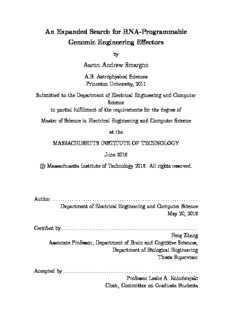
An Expanded Search for RNA-Programmable Genomic Engineering Effectors Aaron Andrew ... PDF
Preview An Expanded Search for RNA-Programmable Genomic Engineering Effectors Aaron Andrew ...
An Expanded Search for RNA-Programmable Genomic Engineering Effectors by Aaron Andrew Smargon A.B. Astrophysical Sciences Princeton University, 2011 Submitted to the Department of Electrical Engineering and Computer Science in partial fulfillment of the requirements for the degree of Master of Science in Electrical Engineering and Computer Science at the MASSACHUSETTS INSTITUTE OF TECHNOLOGY June 2016 ○c Massachusetts Institute of Technology 2016. All rights reserved. Author ................................................................ Department of Electrical Engineering and Computer Science May 20, 2016 Certified by............................................................ Feng Zhang Associate Professor, Department of Brain and Cognitive Sciences, Department of Biological Engineering Thesis Supervisor Accepted by ........................................................... Professor Leslie A. Kolodziejski Chair, Committee on Graduate Students 2 An Expanded Search for RNA-Programmable Genomic Engineering Effectors by Aaron Andrew Smargon Submitted to the Department of Electrical Engineering and Computer Science on May 20, 2016, in partial fulfillment of the requirements for the degree of Master of Science in Electrical Engineering and Computer Science Abstract A biocomputational pipeline was designed and implemented to mine through metage- nomic datasets for novel Class 2 CRISPR (Clustered Regularly Interspaced Short Palindromic Repeat) single effectors, akin to the revolutionary genome-engineering tools Cas9 and Cpf1. Whereas previous search strategies relied on protein proxim- ity to CRISPR-associated spacer acquisition proteins Cas1 and Cas2, this approach was seeded on CRISPR arrays alone. What resulted was the discovery of a potential new Class 2 CRISPR system, with two subtypes as characterized by distinct putative accessory proteins. Follow-up experimental work is required to assess the system’s activity: first, in the presence and absence of the accessory protein; and second, as a single effector protein capable of precise genome engineering in prokaryotic and eukaryotic cells. Thesis Supervisor: Feng Zhang Title: Associate Professor, Department of Brain and Cognitive Sciences, Department of Biological Engineering 3 4 Acknowledgments Beyond acknowledging my mentor Feng Zhang for his guidance, encouragement, and instrumental laboratory resources, I would also like to acknowledge other members of the Zhang Lab–most notably my colleagues Neena Pyzocha and David Cox for work- ing with me to curate and characterize experimentally my computational findings, Kaijie Zheng for initially assisting in interfacing with NCBI BLAST, and Erin Black- well for her patience and dedication to the success of the Zhang Lab and its members. Discussions with Eugene Koonin’s group at the NIH, Bethesda were incredibly help- ful for understanding the work presented. I am grateful to the Broad Institute of MIT and Harvard, NIH, and all indirect sources of institutional support and grant funding that have made my research in the Zhang Lab possible. Additionally I wish to acknowledge my academic advisor Leslie Kolodziejski for her help throughout the S.M. and anticipated Ph.D. process. Finally, I wish to acknowledge my family for their constant support throughout my Master’s degree program. 5 6 Contents 1 Introduction 11 2 Biocomputational Search 13 2.1 Search Parameters and Considerations . . . . . . . . . . . . . . . . . 13 2.2 Visualizing Candidates . . . . . . . . . . . . . . . . . . . . . . . . . . 14 3 Discovering New Class 2 Loci 17 3.1 Properties of Loci . . . . . . . . . . . . . . . . . . . . . . . . . . . . . 17 3.2 Characterizing the Entire Group of Loci . . . . . . . . . . . . . . . . 19 4 Ongoing and Future Experimental Work 25 5 Discussion 29 7 8 List of Figures 2-1 Bioinformatic pipeline and preliminary results . . . . . . . . . . . . . 15 2-2 Protein discovery visualization tool with Cas9 example . . . . . . . . 16 3-1 Two new Class 2 CRISPR loci discovered without Cas1/Cas2 . . . . . 21 3-2 Size distribution of candidate RNA-guided single effectors . . . . . . . 22 3-3 Phylogenic tree of single effectors from two new loci . . . . . . . . . . 23 4-1 Experimental workflow prior to genomic engineering applications . . . 28 9 10
Description: